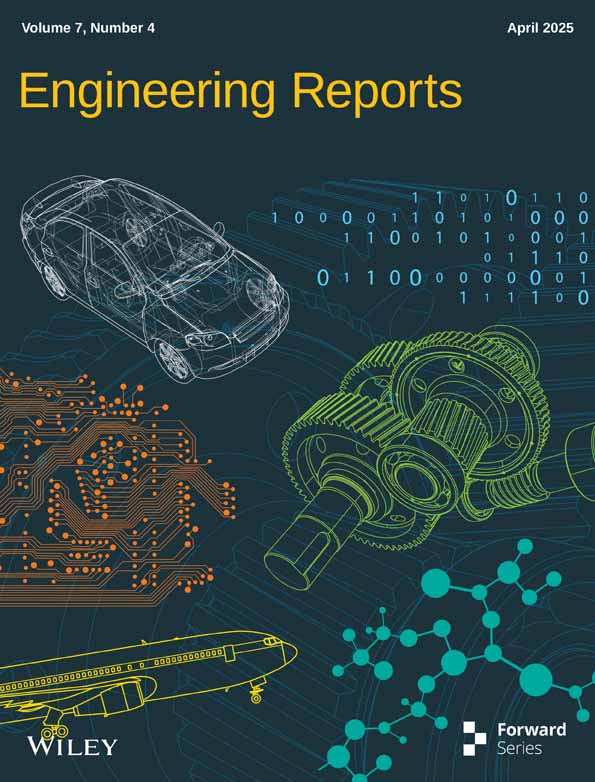Artificial Intelligence and Architectural Design Before Generative AI: Artificial Intelligence Algorithmics Approaches 2000–2022 in Review
ABSTRACT
This study explores the evolution of Artificial Intelligence (AI) applications in the AEC from 2000 to 2022, focusing on the transition leading up to the accessibility of Generative AI in 2023. Through a Bibliometric review of publications indexed in Scopus, Web of Science, and CumInCAD, the research examines the adoption of specific algorithmic approaches: Genetic Algorithms (GAs), Artificial Neural Networks (ANNs), and Agent-Based Systems(ABS). Findings reveal that GAs and ANNs exhibited comparable use until 2015, after which ANNs experienced exponential growth, surpassing GAs by 2016. ABS, although less prominent overall, saw a temporary surge starting in 2008, which established ABS as a distinct research category. Comparative analysis with CumInCAD highlights its early role as a primary repository for specialized research, surpassing WoS and Scopus untill quite a few years afterward. This research underscores key historical milestones marking AI's integration into the AEC, including advancements in evolutionary computation, machine learning, and distributed AI systems. While revealing critical trends, the study acknowledges its limitations, such as database bias and the exclusion of developments post-2023. Future research should extend beyond this period, incorporate qualitative analysis, and explore emerging tools in generative design to understand AI's growing impact.
1 Introduction
The integration of Artificial Intelligence (AI) into architectural design has transformed the construction industry, enhancing efficiency, creativity, and decision-making processes. This study examines the evolution of AI algorithms, specifically Genetic Algorithms (GAs), Artificial Neural Networks (ANNs), and Agent-Based Systems (ABS), in architectural design from 2000 to 2022.
We identify key milestones and shifts in algorithm adoption by analyzing publication trends across databases such as Scopus, Web of Science, and CumInCAD. Our findings reveal that ANNs experienced exponential growth post-2015, surpassing GAs, while ABS gained prominence around 2008, coinciding with the introduction of Depth Map software. These insights contribute to mapping the trajectory of AI integration in architectural design, highlighting the transition from niche research areas to mainstream adoption, and setting the stage for the generative design revolution anticipated in 2023.
It is precisely because of that this research review is proposed from the early 2000s till that historical milestone that can be considered the one that marks the end of the second digital era of computation and architectural design.
- To analyze the evolution of AI applications in architectural design from 2000 to 2022 by reviewing the adoption of GAs, ANNs, and ABS in the field.
- To establish the key milestones that shaped the integration of AI in architectural design, (particularly, in the use of Genetic Algorithms [GAs], Artificial Neural Networks [ANNs], and Agent-Based Systems [ABS]).
- To understand the publication trends in AI-driven architectural research shift over time across different databases (Scopus, Web of Science, and CumInCAD).
2 Scope of the Proposed Research
The second digital era in architectural design can be considered the one starting in the early 2000s.
Although the term Parametricism was coined as a style by Patrik Schumacher in 2005 with his manifesto published in 2008 [1], it was still characterized by all design elements being parametrically variable and mutually adaptive. This second digital era in architecture and city design is characterized by an interest in understanding the new available processes as methodologies for design once the complex system of the building (or city) can be defined by its variables.
This research's second computation era marks the timeline chosen for this research and its end is January 2023 with the LLMs available to the public explosion.
Also, the 18th Conference on Education in Computer Aided Architectural Design in Europe, eCAADe 2000, can be considered a milestone for the birth of widespread use of computational tools and algorithmic structures to generate solutions to complex problems and to create forms. In fact, the conference's 2013 31st edition submitted papers showed a good example of the shifting into the second era as a general homogeneous approach to methodologies (and not on form and aesthetics) was shown by the participants.
These approaches in the field are sometimes referred to as generative architecture. Digital tools have been crucial to generative architecture's development, yet they are also used in other architectural modes. Generative architecture, a significant subset of what Mario Carpo calls The Digital Turn in Architecture [2] is unified by a computational approach. This often results in an aesthetic featuring interconnected, morphing component-based forms with a stylized organic appearance.
Through a literature review process, it is the aim of this research to understand the interest (and use) within the architectural design discipline of the different algorithms within the Artificial Intelligence field.
3 Methodology
Artificial Intelligence (AI) has been making significant strides in various fields, including architecture and architectural design. Over the past two decades, from 2000 to 2022, there have been notable advancements and approaches that have transformed the way architects conceptualize, design, and create buildings. In this brief review, we will explore some key developments in the intersection of AI, architecture, and architectural design during this period.
In the most recent review, Castro Pena et al. [3] focused on understanding the applicability of AI methodologies to the conceptual form and their related publications. Roman et al. [4] developed a closer approach to that of this review by considering artificial Neural Networks but focusing exclusively on building performance simulation.
It has not been found any published review focused on the different algorithms used along the studied period or on how the field approached different AI fields.
A bibliometric analysis is considered a useful method for summarizing and synthesizing the current state of research in the crossings of these two specific fields. By using established methods to search, categorize, and analyze the research, researchers not only identify gaps in the literature but also discover patterns of interest in research and timeline-based approaches related to the different technologies made available to researchers during every historical moment. Additionally, this method provides a more objective and transparent evaluation of the research, as the methodology used can be easily replicated and verified by other researchers.
The research adopts a positivist philosophical approach, which emphasizes objectivity, empirical verification, and the use of scientific methods to uncover cause-and-effect relationships. This approach is well-suited for analyzing observable and quantifiable data, such as the trends in the adoption of algorithms in architectural design. By examining publication data from databases like Scopus, Web of Science, and CumInCAD, the study employs techniques to identify shifts in algorithmic usage over time, ensuring that conclusions are based on objective, verifiable evidence. The focus on measurable phenomena and causal analysis aligns with the core principles of positivism, providing reliable insights into the evolution of computational methods in the field of architecture.
3.1 The Bibliometric Analysis Process
The three most well-known methodologies (Systematic Literature Review), Meta-Analysis, and Bibliometric Analysis are distinct approaches used in research to analyze existing literature, each serving different purposes (see Table 1). A systematic literature review (SLR) is a structured, methodical approach to identifying, evaluating, and synthesizing research studies on a particular topic. A meta-analysis is a statistical technique that combines data from multiple quantitative studies to derive overall findings. A bibliometric analysis is a quantitative method that examines patterns in academic publications using citation, co-authorship, and keyword analysis. Its main purposes are mapping the structure of a research field, identifying influential authors, institutions, and trends, and visualizing research networks. The outcome is normally based on a graphical and/or statistical representation of the evolution of research topics and knowledge dissemination. As so as the main aim of this research will be to identify the most influential papers and research networks in AI and architectural design in the aforementioned time period, this will be the methodology used.
| Systematic literature review (SLR) | Meta-analysis | Bibliometric analysis | |
|---|---|---|---|
| Approach | Qualitative & structured | Quantitative & statistical | Quantitative & citation-based |
| Purpose | Synthesizing and critically evaluating research findings | Aggregating numerical data from studies | Mapping the impact and trends in research |
| Data Type | Thematic analysis of research articles | Statistical data from empirical studies | Keyword metrics, citation, and authorship |
| Output | Summary of key themes, gaps, and future directions | Overall effect size, Trends, and statistical significance | Network visualizations, citation trends, and co-authorship maps |
| Example tools | PRISMA, NVivo | R, MetaXL, SPSS | VOSviewer, CiteSpace, Biblioshiny |
- Source: Author (2025).
The method is particularly well-suited for understanding the use of these two different algorithmic approaches in architectural design-related papers within databases as this methodology enables researchers to comprehensively gather and analyze a wide range of studies that compare or utilize these algorithms, ensuring a thorough understanding of their applications, advantages, and limitations in the field of architectural design. By employing this approach, they can develop precise search strategies that target relevant databases and utilize specific keywords and terms related to the algorithms and architectural design. This allows for the identification of a broad spectrum of studies, encompassing various contexts and perspectives. A Bibliometric Analysis will fit the aim of this research to understand the evolution of research trends, influential authors, and publication networks.
3.2 Inclusion and Exclusion Criteria
The inclusion and exclusion criteria ensure that only pertinent studies are considered, enhancing the relevance and quality of the review. An extensive screening process is employed to choose the pertinent research articles. Establishing inclusion and exclusion criteria is the first step in this procedure, which is used to filter the acquired material [5]. The examined publications are assessed according to their significance to the research objectives, systematic coherence, and capacity to offer insights into AI.
- Relevance to Research Objectives: Inclusion of studies that specifically address the application of the two algorithms in architectural design.
- Quality of Research: Selection of studies that meet high standards, such as peer-reviewed articles or influential conference papers.
- Publication Date: Consideration of studies published within a certain period to ensure the findings are current and relevant.
- Language: Inclusion of only studies published in English to maintain consistency in the review.
By applying these criteria, the review achieves a focused and high-quality synthesis of the literature, providing a robust foundation for understanding the application of these algorithms in architectural design. They will also discard the ones that approached AI used for some engineering authors that were focused only on structural optimization from a mere engineering point of view.
The synthesis of the data revised provides a comprehensive overview of how the algorithms are used, their comparative performance, and their impact on architectural design outcomes.
4 Historical Period Reviewed
At the beginning of any research, it is essential to determine the development process of the research topic and whether the field is of academic interest. For this purpose, a bibliometric analysis based on the year of publication of the article was used.
As shown in Figure 1, the temporal distribution of articles increased exponentially from 2010. The analysis of that period will allow us to probably answer the research question.
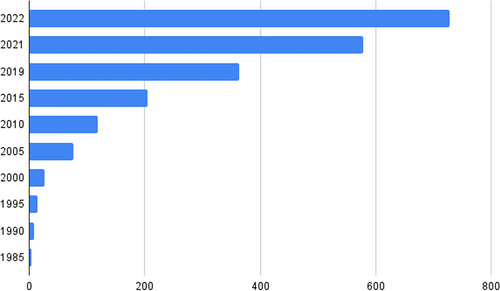
Also, for the purpose of understanding the relevant period and timeframe that needed to be studied it was developed a mapping comparing mayor AI development milestones and architecture and AI-related technology well-documented historical ones. In the figure shown (Figure 2), the events mapped have been represented in parallel timelines to allow easy comparison.
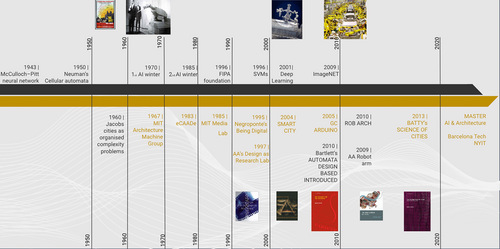
As so, three main milestones within the AI domain have been fundamental to the decision-making process for the literature review period to be reviewed.
The first one is what is the second AI winter. Characterized by the AI investment market collapse, considered to be finished by the appearance of probabilistic reasoning, and introduced by Judea Pearl's influential work [6], in particular with Bayesian networks. Algorithms were unable to do anything more than simple tasks like recognizing objects or understanding simple commands. This made many people lose faith in AI and think that it would never be able to do anything more than these simple tasks. Also, that specific moment coincides with the timeline of its ending, 1985, with the creation of the MIT Media Lab that evolved from the initial Negroponte “Architecture Machine Group” of fundamental historical relevance.
The second one was the 1996 creation of F.I.P.A.1 Foundation for Intelligent Physical Agents. Its appearance on the research scene provoked a big step forward regarding the implementation of the Space Syntax methodologies proposed by Hillier in 1984 [7]. Hillier and Penn proposed in 1993 [8] through the analysis of three case studies in London a method for predicting pedestrian movement for the first time not based on the adaptation of the ones developed for vehicles.
Pedestrian movement was seen as depending on the capability of attraction of the different built forms, and the implementation was followed by the first Agent-based spatial analysis by Turner et al. in 2001 [9].
4.1 The Third Milestone: The Architecture Digital Eras & Turns
Despite the first approaches for Deep Learning dated as far back as the early 2000s, it was not until ImageNet was made available that the next milestone was considered, as it was then when, realistically, data training and learning was made available for non-experts. Interest in AI revived with the advent of expert systems and distributed processing.
Also, the implementation of the first formal method for spatial analysis based on Space Syntax methodologies was transformed into open-source software, UCL depth map, seeing the light of the first agent-based system for spatial analysis based strictly on mathematical analysis of spatial graphs and visibility calculations.
This third milestone historically coincides with what Mario Carpo coined as “the second digital era” in his book in 2017 [2] for the field of architectural design as previously mentioned. For the author, a second type of relationship between the architect and computation emerged then. Far from the 90's 00's approach to computation merely aimed at a complexity on the final form, a secondary rea for the crossings of the two disciplines, AI and architectural design, has arisen. The interest lies now on the processes rather than on the ends being the approach focused on the creating and merging of AI-based hybrid methodologies for design.
4.2 The Fourth Milestone: Generative AI
December 2022 observed the birth of the accessibility to the type of technologies that will enclose the period to be covered by this research. The appearance of open-to-the-public LLMs like ChatGPT, GANs like Midjourney settled the milestone that opened the next era regarding the relationship of AI and architectural design.
The big breakthrough in accessibility to non-experts of these types of technologies caused in 2023 a highly dense generative AI-based brainstorming period where the culture of hallucination for image creation was born in Architecture.
5 Categorization of the Field of Study. Sub Symbolic AI, Machine Learning, & Embodied Intelligence
Opposite to one of the few existing reviews on AI use in architectural design [10], the focus of this research is not on the uses of the AI-based tools that architects pursue but on the algorithmic approach for those processes which define the fundamentals of the methodologies used.
For this research, approaches from 2000 to 2022 have been categorized into several categories (Figure 3) defined as related to the different approaches found in the literature.
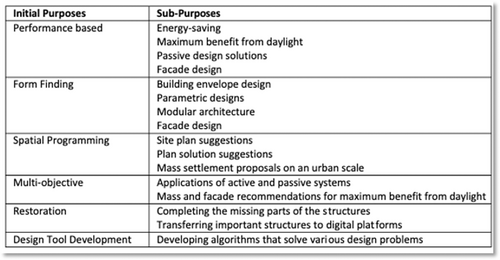
5.1 Parametric Design and Computational Design Tools
One of the early impacts of AI on architecture was the emergence of parametric design and computational design tools. Early approaches to computation will be radically complex forms based and will be guided by approaches like that of Patrick Schumacher [1] for Zaha Hadid architects or the Design as Research Laboratory of the Architectural Association of London. After an initial period of tools coming from other fields of expertise (like CATIA2 from aerospace engineering), which were used within the architectural design field despite their limitations, a new series of architecture-focused tools appeared on the scene.
- Augmented Reality (AR) and Virtual Reality (VR):
- Machine Learning and Pattern Recognition:
- Evolutionary Algorithms and Genetic Algorithms
- Agent-based systems and reinforced learning
- Generative Design
- Building Information Modeling
This research will consider categories 2, 3, and 4 (Machine Learning & pattern recognition, Evolutionary algorithms & genetic algorithms and Agent-based systems & Reinforced learning). Categories 1, 5, and 6 are strongly software development related. As such, they can be categorized as in need of having their own review, as the literature related to the development of these tools and software is specific. This research will focus on the use of machine learning and AI for architectural design and not on the tool's development process.
- The first category would be the one related to evolutionary computation and optimization for procedures: Sub-symbolic AI.
- The second category will be the one related to pattern recognition, classification, decision-making processes, and prediction analysis. Statistical AI & Machine Learning.
On the contrary to the categorizations shown in the previous table by Bolek et al. analysis along the chosen period for study has been developed according to a more close to the AI field classification.
As so, as it can be appreciated from the table (Figure 4), being Evolutionary computation classified as Subsymbolic, the whole focus on the research will be to understand if from search and optimization processes the profession has shifted to an exponential interest in statistical AI with the appearance of GANs as algorithms accessible to the non-expert public.
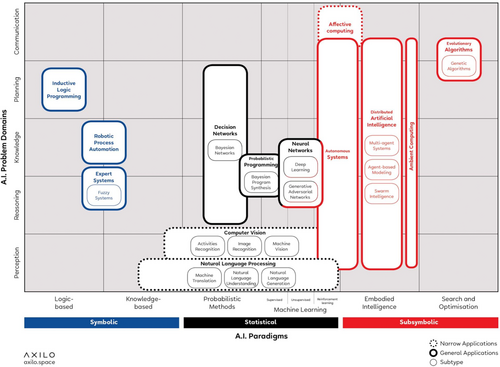
As so, it will also be included along the lines of the investigation of what for the researcher is understood as the next logical step: the understanding of the relevance of distributed AI via multi-agent systems and agent-based modeling.
- the third considered category will be the one of Embodied Intelligence.
6 Sub Symbolic AI, Machine Learning & Embodied Intelligence Representative Algorithms for Investigation
- Category 1: Sub-symbolic AI.
- Category 2: Statistical AI & Machine Learning.
- Category 3: Embodied Intelligence.
For this research data finding, the following definitions of the algorithms were used in order to validate the inclusion of the publications:
Evolutionary Algorithms (EA): it is a subset of a broader computer science domain called evolutionary computation that uses mechanisms inspired by biology (e.g., mutation, reproduction, etc.) to look for optimal solutions. Genetic algorithms are the most used sub-group of EAs, which are search heuristics that follow the natural selection process to choose the “fittest” candidate solution.
Artificial Neural Networks (ANNs): modeled after the neuronal structure of the human brain. The two major and well-known sub-classes of ANNs are Deep Learning (a neural net with multiple layers) and Generative Adversarial Networks (GANs—two networks that train against each other and discarded for this research as their appearance to architects happened in 2023).
Distributed Artificial Intelligence (DAI): a class of technologies that solve problems by distributing them to autonomous “agents” that interact with each other. Multi-agent systems (MAS), Agent-based modeling (ABM), and Swarm Intelligence are based on collective behaviors that emerge from the interaction of decentralized self-organized agents.
7 Relevant Databases
Analyzing thematic data entails placing and classifying major themes that are produced by the literary choices made. This analytical template is a deliberate method for finding recurring themes, patterns, and trends in the data [12]. By elaborating and summarizing the retrieved data, the research seeks to create a more comprehensive, generalized picture of the present trends and potential vectors of AI engagement in architectural design.
In order to determine the appropriate databases, libraries, and other sources to search for relevant literature, there were included academic databases (Scopus and Web of Science) and subject-specific databases (CUMINCAD). In order to confirm the analysis using secondary data from the literature research, the triangulation approach was employed [13].
8 Results and Findings
8.1 Artificial Neural Networks (ANNs)
Artificial Neural Networks (ANNs) have played a significant role in advancing architectural design by enabling architects to leverage the computational power of AI to generate innovative design solutions. ANNs are computational models inspired by the structure and functionality of the human brain [14].
The first part of the study was focused on understanding the implementation of Genetic Algorithms and ANNs capable of learning and recognizing complex patterns, and architects have utilized ANNs for various purposes in architectural design.
Early implementations of ANNs in architecture focused on pattern recognition and performance prediction, allowing architects to optimize energy efficiency, material usage, and spatial configurations. A key application of ANNs in architectural design has been in performance-driven design [15], where these models are trained on extensive datasets of building performance parameters to enhance energy efficiency and structural stability [16]. Moreover, ANNs have been widely used in generative design processes, enabling the creation of optimized forms based on predefined constraints [17]. These systems have been particularly useful in adaptive facades and sustainable building design, where the neural network predicts environmental responses and suggests optimal facade configurations. Approaches with a focus on generative process implementations have not been considered as they are out of this research timeline; i.e., by training ANNs on a dataset of architectural precedents and associated design features, architects can employ these models to generate new design options that adhere to specific requirements. As such, most of the ANNs publications included have used for performance prediction and optimization.
8.2 Agent-Based Systems
Agent-Based Systems (ABS) have emerged as a crucial methodology in architectural computation, particularly for urban planning and spatial analysis [18]. These systems simulate the behavior of autonomous agents, such as pedestrians, vehicles, or environmental variables, to predict and optimize spatial interactions [9]. ABS have gained significant traction in space syntax analysis, where they have been used to model human movement and accessibility within urban environments [19].
Alasdair Turner made significant contributions to the field of agent-based systems, focusing on the development and application of intelligent agents for various domains. His work has explored the design, behavior, and coordination of autonomous agents to achieve complex tasks and solve real-world problems. In one of his notable studies, Turner proposed a framework for multi-agent systems. Turner's research also delved into the application of agent-based systems in dynamic environments.
A notable advancement in ABS within architectural research is the development of DepthmapX, a tool pioneered at UCL for simulating pedestrian movement using agent-based models [20]. Research has demonstrated that agent-based models provide more accurate predictions of urban behavior compared to traditional geometric analyses [21]. Furthermore, studies have integrated reinforcement learning within ABS to enhance the adaptability of spatial configurations based on real-time user interactions [22]. The particular event can be appreciated in the results timeline as showing an increased number of these types of approaches in publications. Also, from 2018, it can be appreciated that an increased interest in an approach more focused on collaborative cognition.
8.3 Main Findings
The research, grounded in a comprehensive review of scientific publications indexed in Scopus and Web of Science, reveals key trends in the adoption of algorithms in architectural design up to 2020. Genetic Algorithms (GAs) and Artificial Neural Networks (ANNs) maintained comparable usage levels until 2015. However, the use of ANNs grew exponentially from that point, surpassing GAs by 2016 [23] and dominating the field thereafter (Figure 5).
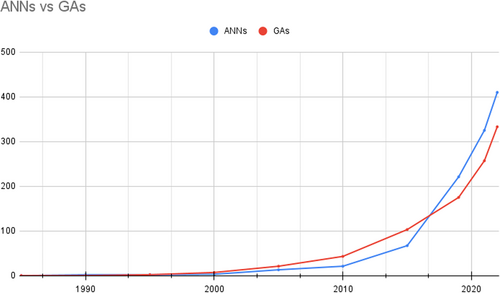
Other AI algorithms, including agent-based systems, have consistently shown lower impact over the studied period. Notably, even with the emergence of advanced tools like Depth Map X [24], the influence of agent-based systems has remained minimal. (Figure 6) Nevertheless, the analysis of scientific publications highlights a significant shift in the prominence of agent-based systems within architectural design research starting in 2008. This surge aligns with the introduction and public availability of Depth Map software for spatial analysis, which catalyzed increased interest and application of these systems. As a result, agent-based systems temporarily surpassed the impact of Genetic Algorithms (GAs) and Artificial Neural Networks (ANNs) during this period, establishing themselves as a distinct and noteworthy category in the field. This surge highlights ABS as a distinct category in architectural research, particularly within urban analysis and spatial simulation [25]. The role of CumInCAD as an early repository for computational design research is also significant; it held more publications on AI applications in architecture compared to Scopus and Web of Science until 2020, reflecting its role in early-stage research dissemination [26].
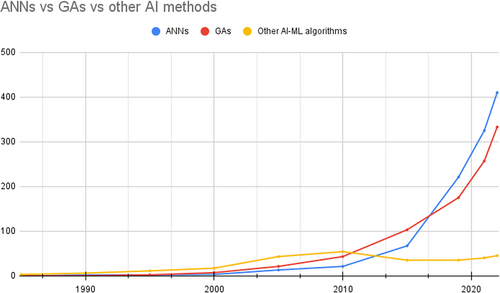
8.4 The Case of CUMINCAD
To deepen the understanding of algorithmic applications in architectural design, the second phase of the research incorporates CumInCAD, a specialized database for publications focused on architectural design and computation. CumInCAD, short for Cumulative Index of Computer-Aided Architectural Design, is a curated repository that aggregates research papers, conference proceedings, and other academic contributions directly related to computational design in architecture [27]. Its relevance lies in its focused scope, capturing niche and domain-specific advancements often overlooked in broader databases like Scopus and Web of Science. (Figure 7) This platform was particularly relevant in the early 2000s when AI applications in architecture were still emerging [28].
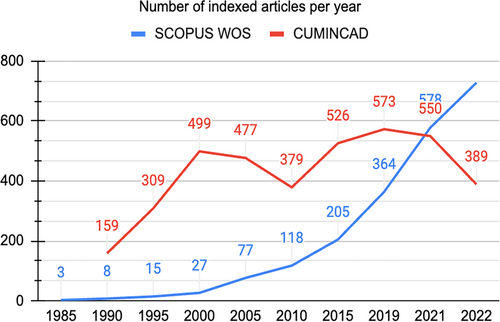
By comparing the results from Scopus and Web of Science with those from CumInCAD, this section aims to identify overlaps, divergences, and unique trends. This comparative analysis not only validates broader observations but also highlights domain-specific contributions and insights that are pivotal for understanding the evolution of algorithmic methods in architectural design. Such a comparison ensures a more comprehensive mapping of the field, bridging the gap between general and specialized knowledge sources.
Comparing the results from Scopus, Web of Science, and CumInCAD revealed a shift in publication distribution from CumInCAD to broader databases post-2020 [29]. This trend underscores the mainstreaming of AI techniques, moving beyond niche computational design communities into broader architectural research domains [30]. The analysis of specific algorithms further corroborates this trend, with ANN-related publications overtaking those of GAs and ABS by 2016 [31].
The analysis of publications within CumInCAD revealed a higher number of research outputs compared to Scopus and Web of Science until 2020. This trend is indicative of the early stages of the widespread implementation of computational design techniques in architecture. During this period, most publications in the field were concentrated in CumInCAD, reflecting its role as a key platform for disseminating specialized research. However, as these techniques became more accessible and widely adopted, the publication landscape began to shift, with contributions appearing more frequently in broader academic databases like Scopus and Web of Science. This transition underscores the growing maturity and mainstream integration of computational design methods within architectural research, and it remains the same nowadays.
The same pattern emerges when the research focuses on specific algorithms, Genetic Algorithms (GAs), and Artificial Neural Networks (ANNs) (see Figure 8). CumInCAD consistently exhibited a higher number of publications on these topics compared to Scopus and Web of Science. This finding reinforces the notion that CumInCAD served as the primary repository for specialized research in the early stages of algorithmic development in architectural design. As it can be observed in both figures (Figure 9), the number of publications within Cumincad started to decrease drastically in 2020, crossing the final number from Scopus and WOS in 2021.
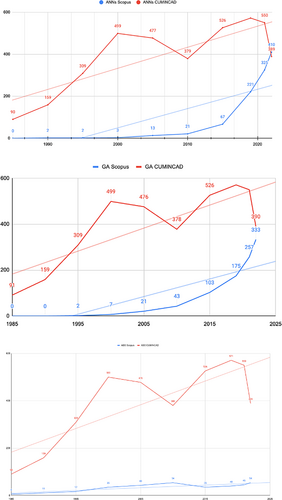
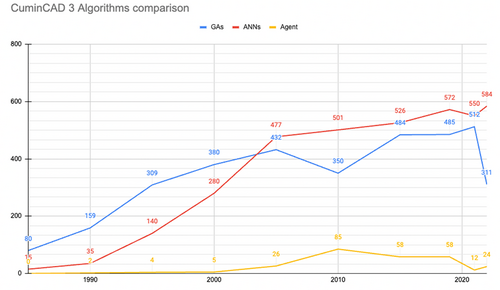
9 Conclusions and Final Remarks
This study explores the evolution of algorithmic applications by analyzing two decades (2000–2022) of research indexed in Scopus, Web of Science, and CumInCAD. The findings reveal significant trends in the adoption and dissemination of AI-driven computational techniques, offering insights into their growing impact on the field of construction automation.
GAs and ANNs maintained comparable usage levels until 2015. However, starting in 2015, ANNs experienced exponential growth, surpassing GAs by 2016. This reflects a paradigm shift where ANNs enable performance optimization, predictive analysis, and automated decision-making.
The rise of Agent-Based Systems (ABS) while less prominent overall, ABS exhibited a temporary surge in 2008. This coincided with the release of Depth Map software for spatial analysis, marking ABS as a distinct category that optimized spatial design in complex environments like urban planning.
The role of CumInCAD: Compared to Scopus and Web of Science, CumInCAD played a critical role during the early adoption phase of computational techniques, serving as the primary platform for disseminating specialized research on GAs and ANNs. As AI techniques became more accessible, publications shifted to broader databases, highlighting the mainstreaming of computational methods into construction workflows.
These findings contribute to the field by identifying how AI algorithms enhance automation in architectural design, highlighting key milestones that align with advancements in automation, and laying the groundwork for generative design tools emerging post-2023. The transformative growth of ANNs, as depicted in the timeline, underscores how these developments have disrupted design practices and catalyzed broader industry adoption. This research maps the historical evolution of AI applications in architectural design, empowering researchers and practitioners to leverage these advancements for enhanced efficiency, scalability, and automation in the construction industry.
Study limitations include reliance on database coverage (Scopus, Web of Science, CumInCAD), a focus on publication trends rather than qualitative impact, and a temporal cutoff in 2020, which excludes transformative advancements in generative AI leading up to 2023. Future research should address these gaps by incorporating content analysis, analyzing recent trends, and expanding data sources to provide a more holistic understanding of AI's impact on construction automation.
10 Future Goals and Perspectives for AI in Architecture
The integration of Artificial Intelligence in architectural design continues to evolve, with future advancements poised to redefine design methodologies, automation, and decision-making processes. While previous AI applications have primarily focused on optimization, simulation, and rule-based generative processes, the advent of Generative AI (GenAI) introduces a paradigm shift that demands dedicated exploration. The accessibility of Large Language Models and Generative Adversarial Networks to non-experts has accelerated experimentation in design ideation, mass customization, and adaptive architectural solutions (Figure 10). However, despite its growing influence, a scholarly study specifically addressing the implications, limitations, and methodological integration of GenAI within architecture is still lacking.

Future research must critically assess how GenAI reshapes architectural workflows, its potential biases, and the balance between human-driven creativity and machine-generated outputs. Furthermore, interdisciplinary approaches bridging AI, material science, and sustainable design could unlock new potentials for intelligent, performance-driven architecture. By establishing a structured framework for GenAI's application, future studies will contribute to a more coherent understanding of its role in architecture, beyond its current experimental and often speculative implementations. Currently, three trends are shaping the use of GenAI in architecture: AI-driven conceptual design, where generative models enable rapid ideation and visualization of architectural concepts, expanding the range of aesthetic possibilities; Automated design-to-construction pipelines, where AI-generated models are directly integrated into Building Information Modeling workflows; and AI-enhanced spatial optimization, where deep learning algorithms analyze functional and environmental constraints to generate optimized layouts for efficiency and sustainability.
Beyond GenAI, Distributed AI and Agent-Based Learning (ABL) offer promising directions for architectural intelligence, particularly in adaptive urban systems and real-time decision-making. Distributed AI can enable multi-agent design systems where different AI models collaborate to generate and evaluate architectural solutions. ABL, on the other hand, provides a framework for simulating and optimizing complex architectural behaviors, such as pedestrian flow, spatial adaptability, and energy efficiency. By incorporating reinforcement learning techniques, agent-based systems can iteratively improve building performance by analyzing interactions between users, spaces, and environmental factors. Future research should focus on integrating these AI-driven methodologies into architectural workflows, bridging the gap between digital simulation, human-centric design, and real-time adaptive systems.
Author Contributions
Ana Cocho-Bermejo: conceptualization, investigation, writing – original draft, methodology, validation, visualization, writing – review and editing, formal analysis, software.
Conflicts of Interest
The author declares no conflicts of interest.
Endnotes
Open Research
Data Availability Statement
The data that support the findings of this study are available on request from the corresponding author. The data are not publicly available due to privacy or ethical restrictions.



